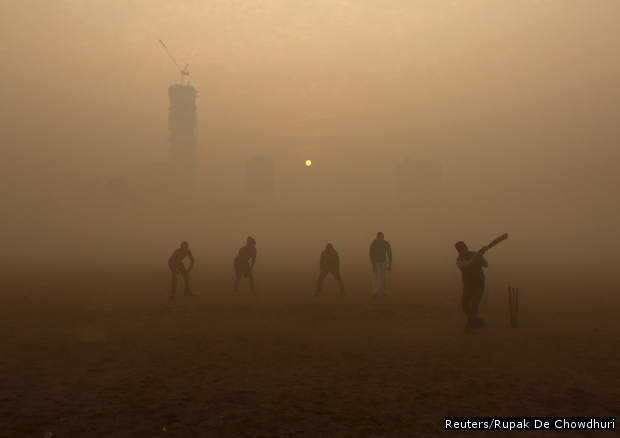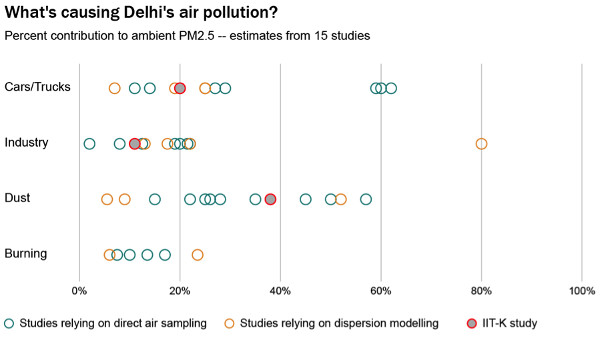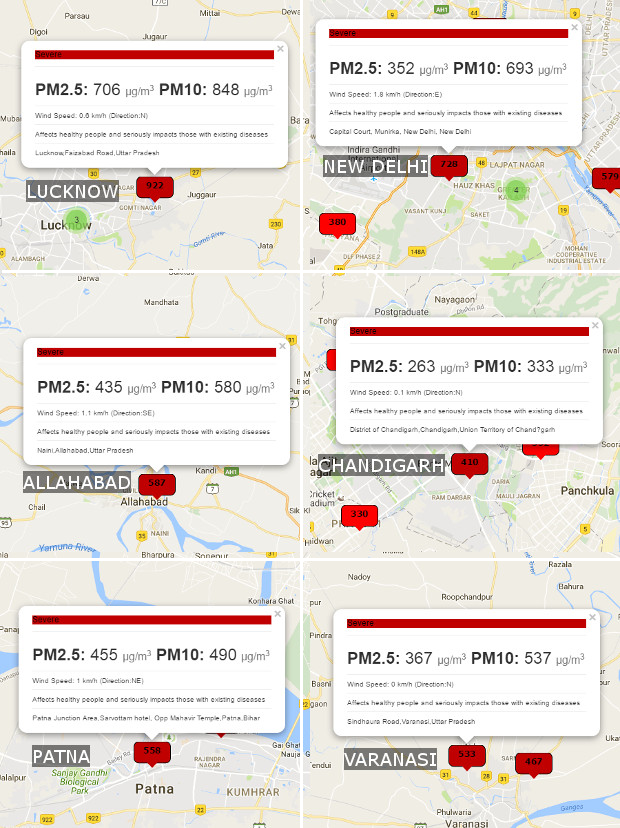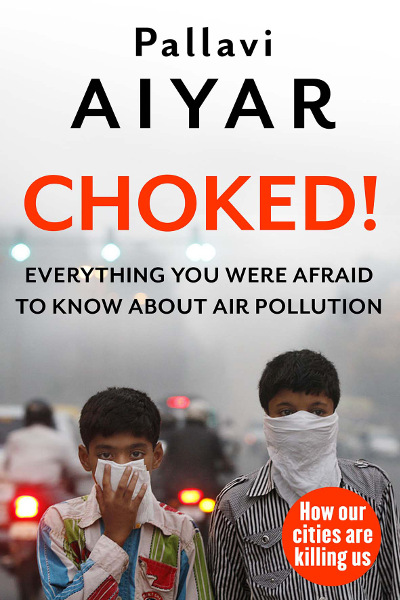‘95% Of China’s Power Plants Have Pollution Filters, In India, 10% Do’
Delhi’s smog may have made national headlines in early November 2016--when air-quality levels exceeded by 40 times safe limits set by the World Health Organization (WHO)--and subsequently receded from public attention. But as IndiaSpend was interviewing Pallavi Aiyer, author of ‘Choked’, a new book that investigates Delhi and India’s air-pollution crisis, the air was unhealthy or worse in the majority of 17 cities where our sensors are installed. Aiyer, a journalist who's lived and reported from some of the most polluted cities in the world, including Beijing and Jakarta, argues that many countries have been in India’s situation, and India would do well to learn from their experiences. For instance, China--long regarded as an example of what not to do in controlling air pollution--has rapidly and efficiently improved its policies and air quality. IndiaSpend’s Alison Saldanha spoke to Aiyer.
1) Recently, Delhi and the region around the capital reported 24-hour average air pollution levels (over 900 µg/m³ of PM 2.5, fine, toxic particles that embed themselves in respiratory and cardiac systems) nearly 40 times above the WHO’s guidelines (25 µg/m³). How hazardous is this? What makes our situation unique and particularly dangerous?
It is hazardous, with most pollutants at several times the acceptable limits. Fine particulate matter that is less than 2.5 micrometers in diameter has been linked to up to 16,200 premature deaths (and a staggering six million asthma attacks) per year in Delhi alone. There are reports that one of every four children in the Indian capital suffers from a serious lung disorder. Other constituents of air pollution such as Sulfur Dioxide, Ozone and Nitrogen Oxides are associated with a range of short-term and long-term health effects from reduced lung capacity, shortness of breath, to heart disease and even cancer.
But Delhi’s air pollution is not unique. India is a large, industrialising, populous, developing country and all countries in similar circumstances have undergone extensive episodes of polluted air.
Pollution is a multifaceted phenomenon that results from a combination of vehicular, industrial and household sources. The burning of fuels such as coal leads to noxious gases such as Sulfur Dioxide. Diesel engines spout huge amounts of Nitrogen Oxides. Construction dust contributes to coarse particulate matter. And all of these sources are responsible for finer particulate matter, what we call PM 2.5. The burning of trash and leaves in the winter, which is a common practice in northern cities, adds to the toxicity as does agricultural burning.
Based on an analysis by Eric Dodge & Rohini Pande at the Evidence for Policy Design (EPoD) at Harvard Kennedy School. First published here on IndiaSpend in January 2016
In addition to all these, Delhi also suffers from its geography. The Indian capital is landlocked, with few avenues for flushing toxic air out of the city unlike, say, Mumbai. It is also located in a highly polluted air-shed and badly affected by the industrial and agricultural activity across the northern plains of India.
2) PM 2.5 of over 250 µg/m³ can adversely affect even healthy persons, particularly posing a risk to infants and the elderly, says India’s Central Pollution Control Board. What makes these age groups disproportionately vulnerable?
Children are the most vulnerable because their respiratory defenses have not reached their full capability. They also breathe in more air per kilo of body weight than adults; so they take in more toxins per kilo of body weight than adults do. Moreover, children generally exercise outdoors more than adults.
The elderly are often frail and with failing immunity. They are also likely to have pre-existing medical conditions that can exacerbate and further complicate the effects of air pollution.
Source: World Health Organization's 2016 report on ambient air pollution: A global assessment of exposure and burden of disease
3) Beijing no longer features in the WHO’s list of 20 most polluted cities. What are the lessons we can learn from their robust efforts to improve air quality? Could you elaborate on what they are doing that we aren't, particularly with industries?
Although Beijing may still be a poster child for what not to do on the issue of pollution in the international imagination, China has actually undertaken far-reaching and difficult measures to ensure that the worst is over.
According to NASA satellite data, the PM 2.5 levels across India got worse by 13% between 2010 and 2015, while China’s steadily improved. Last year was the worst on record for India in terms of particulate pollution and the best in China. PM 2.5 levels across China fell by 17% between 2010 and 2015, with quite a dramatic improvement towards 2015 (Beijing saw a 16% annual fall in PM 2.5 levels).
Source: Greenpeace India, based on data from Global Burden of Disease, A worldwide collaborative effort to measure the impact of health problems on people.
Source: Analysis by Greenpeace India, based on monthly Aerosol Optical Depth measurements from the NASA MODIS Aqua satellite.Note: Drag the slider to compare air pollution in 2011 and 2015.
China has instituted a broad, regionally coordinated system of air pollution monitoring, installed high-tech pollution abatement equipment on a majority of its power plants, as well as devised means to restrict car ownership in major cities. It has also developed a network of 1,500 air quality-monitoring stations in over 900 cities (India has only 39 such stations covering 23 cities). Significantly, China has instituted regional air quality regulations to ensure that air pollution is addressed jointly across city and state boundaries.
When it comes to industrial pollution, China’s biggest success has been the installation of basic pollution abatement equipment on a majority (95%) of its thermal power plants. In contrast, only 10% of Indian power plants have similar equipment. China’s coal use is also down and coal-fired power plants are increasingly efficient. Finally, the country has emerged as a leading producer of pollution-abatement equipment.
4) What are the systemic problems in implementation that need immediate attention to help India achieve better air quality nearly as soon as China has? (For example, staffing).
Setting deadlines for meeting national air quality standards, as well as five-year interim targets for reducing pollution at state and city levels is one measure. Regional action plans that cover entire air-sheds/regions and address all major sources of pollution, rather than focusing on just some, is another. More empowered and better-staffed pollution control boards are needed. India’s Central Pollution Control Board has 550 employees. The Delhi pollution control board has less than 200 staff. In contrast, the environmental protection bureau (EPB) of the city of Yantai in China’s Shandong province alone has 4,000 staff. We also need to develop more local-level environmental institutions to regulate and implement anti-pollution policies. India only has pollution control boards at the national and state levels. China has EPBs at national, provincial, prefectural, city or county, and district levels. It even has some EPBs at the multi-provincial level. Finally, it’s important to create a large network of monitoring stations in all major urban centers.
5) What are the notable international great smog events in history that Delhi seems to have paralleled this year after Diwali? What made these similar? And what makes Delhi different from those horror stories?
The path to clean air for even the countries that are today rich and safe is littered with horror stories. One example is the small industrial town of Donora, Pennsylvania, in the United States, which was engulfed by a putrid fog on October 26, 1948. Unlike usual fogs, it did not dissipate, staying on the ground for five days. Twenty people died in Donora and 7,000 were hospitalized with respiratory problems. The cause was a weather anomaly that trapped toxic waste emissions from the town's zinc smelting plant close to the ground. The Donora disaster brought air pollution into focus in the United States, and paved the way for the Clean Air Act of 1963 that was later strengthened in 1970.
The air pollution levels in Lucknow, New Delhi, Allahabad, Chandigarh, Patna and Varanasi were 11 to 28 times above the World Health Organization's guidelines when this story was uploaded at 8 PM on November 20, 2016, according to IndiaSpend sensors.
Similarly, in London, toxic smog trapped in a thermal inversion during a week in December 1952 is thought to have killed 4,000 people prematurely. This incident helped pave the way for England's Clean Air Act in 1956.
Much closer to home, geographically and temporally, was last winter’s smog in Beijing which forced the city to trigger its first ever Red Alert, the highest tier of the four-colour smog warning system China set up in 2013. During this time, PM 2.5 levels in the Chinese capital exceeded 900-1000 µg/m³ in some parts of the city (the safe limit is about 50 µg/m³).
What makes Delhi’s fight against pollution today different from historic episodes is that research on the ill effects of dirty air is both more advanced and more widely disseminated. There is no need for us to reinvent the wheel. Technologies including pollution abatement equipment, renewable energy and better-grade fuel exist, that did not a half-century ago. Moreover, we now have a substantial urban middle-class for whom making a daily wage is no longer the driving force of life--allowing health to become a motivating concern.
6) In your book, you’ve talked about pollution in the industrialisation phase in developed countries. How did they improve their air quality to present standards and what solutions can we in India takeaway from those experiences?
There was no magic wand. Air pollution is a man-made problem with practical solutions available. In the wake of horrific pollution and growing citizen disenchantment with dirty air, countries such as the US and UK enacted environmental laws. The US Clean Air Act established a national programme with allocated funding to research techniques for monitoring and controlling air pollution, as well as to enforce interstate air pollution regulations pertaining to vehicles and industry. It paved the way to the setting up of the Environmental Protection Agency (EPA), an institution that consolidates pollution-related research, monitoring, standard-setting and enforcement activities into one body. The EPA has about 18,000 full-time employees.
'Choked' by Pallavi Aiyar is exclusively available on the Juggernaut app.
The UK Clean Air Act introduced “smoke control areas” in some cities whereby only smokeless fuels could be burned. It helped shift homes towards using cleaner sources of heat such as electricity and gas, reducing smoke pollution and Sulphur Dioxide from household fires. The Act also included measures to relocate power stations away from cities.
7) Simply put, what should India’s to-do list be, when should action begin and how long do you think it will be before we see some improved air quality in the National Capital Region?
Concerted action should begin now for improved air quality to become a sustainable reality in about 15-20 years. It’s a long slog, but it will allow our children and grandchildren to stop choking and start breathing. The to-do list is long. Here are some essentials:
- Expanding the scope and quality of public transport.
- Stringent vehicular emissions norms and availability of high-grade fuel.
- Congestion charges and higher parking fees are steps to consider.
- Installing pollution abatement equipment on all power plants.
- Reducing coal usage.
- The development of a large network of monitoring stations in all major urban centers.
- Since the general power grid regularly fails in Delhi and other Indian cities, wealthy residents, hospitals and businesses use diesel-generators in the city centre. A focus on making the grid more reliable will therefore also help slash ambient pollution during the summer months.
- Finally, given the high percentage of PM 10 that originates from road dust, paving more roads to reduce the amount of dust is a must.
8) What is your take on government air pollution monitoring sensors vis-à-vis the growing citizens' movement of crowd-sourcing air pollution data from their own sensors, using laser eggs etc.?
The two should exist in conjunction. Government data can be usefully supplemented by crowd-sourced data. The former gives a broad overview while the latter can tell you what the situation in a specific location, at a given time, is. Laser eggs might not give the most accurate readings, but they give estimates that are good enough to base certain decisions on, like whether or not to exercise outdoors.
9) What is the to-do list for citizens in this movement toward better air quality?
Carpooling, composting and consuming with care. Avoiding polluting behaviours like trash burning or bursting firecrackers. Demanding change from elected representatives.
(Saldanha is an assistant editor with IndiaSpend.)
We welcome feedback. Please write to respond@indiaspend.org. We reserve the right to edit responses for language and grammar.
__________________________________________________________________
“Liked this story? Indiaspend.org is a non-profit, and we depend on readers like you to drive our public-interest journalism efforts. Donate Rs 500; Rs 1,000, Rs 2,000.”







